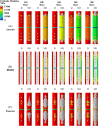A coupled computational framework for bone fracture healing and long-term remodelling: Investigating the role of internal fixation on bone fractures
- PMID: 35485134
- PMCID: PMC9540005
- DOI: 10.1002/cnm.3609
A coupled computational framework for bone fracture healing and long-term remodelling: Investigating the role of internal fixation on bone fractures
Abstract
In this study, a coupled computational modelling framework for bone fracture repair is presented that enables predictions of both healing and remodelling phases of the fracture region and is used to investigate the role of an internal fixation plate on the long-term healing performance of a fracture tibia under a range of different conditions. It was found that introduction of a titanium plate allowed the tibia to undergo successful healing at higher loading conditions and fracture gaps, compared with the non-plated versions. While these plated cases showed faster rates of repair in the healing phase, their performance was substantially different once they entered the remodelling phase, with substantial regions of stress shielding predicted. This framework is one of the few implementations of both fracture healing and remodelling phases of bone repair and includes several innovative approaches to smoothing, time-averaging and time incrementation in its implementation, thereby avoiding any unwanted abrupt changes between tissue phenotypes. This provides a better representation of tissue development in the fracture site when compared with fracture healing models alone and provides a suitable platform to investigate the long-term performance of orthopaedic fixation devices. This would enable the more effective design of permanent fixation devices and optimisation of the spatial and temporal performance of bioabsorbable implants.
Keywords: bone fracture healing; finite element modelling; orthopaedic implants.
© 2022 The Authors. International Journal for Numerical Methods in Biomedical Engineering published by John Wiley & Sons Ltd.
Conflict of interest statement
The authors declare no conflict of interest(s) in the work presented.
Figures











Similar articles
-
A multi-domain computational framework investigating the short- and long-term viability of bioabsorbable magnesium fixation for tibial fractures.Comput Biol Med. 2025 Jan;184:109444. doi: 10.1016/j.compbiomed.2024.109444. Epub 2024 Nov 27. Comput Biol Med. 2025. PMID: 39608034
-
Biomechanical and histological evaluation of the application of biodegradable poly-L-lactic cushion to the plate internal fixation for bone fracture healing.Clin Biomech (Bristol). 2008;23 Suppl 1:S7-S16. doi: 10.1016/j.clinbiomech.2008.01.005. Epub 2008 Mar 4. Clin Biomech (Bristol). 2008. PMID: 18291564
-
Mechanical performance and implications on bone healing of different screw configurations for plate fixation of diaphyseal tibia fractures: a computational study.Eur J Orthop Surg Traumatol. 2021 Jan;31(1):121-130. doi: 10.1007/s00590-020-02749-5. Epub 2020 Jul 28. Eur J Orthop Surg Traumatol. 2021. PMID: 32725431
-
Evolution of the internal fixation of long bone fractures. The scientific basis of biological internal fixation: choosing a new balance between stability and biology.J Bone Joint Surg Br. 2002 Nov;84(8):1093-110. doi: 10.1302/0301-620x.84b8.13752. J Bone Joint Surg Br. 2002. PMID: 12463652 Review.
-
Evolution of fracture treatment with bone plates.Injury. 2018 Jun;49 Suppl 1:S2-S7. doi: 10.1016/S0020-1383(18)30294-8. Injury. 2018. PMID: 29929687 Review.
Cited by
-
[A study on the predictive model of porous hyperelastic properties of human alveolar bone based on computed tomography imaging].Sheng Wu Yi Xue Gong Cheng Xue Za Zhi. 2025 Apr 25;42(2):359-365. doi: 10.7507/1001-5515.202408014. Sheng Wu Yi Xue Gong Cheng Xue Za Zhi. 2025. PMID: 40288979 Free PMC article. Chinese.
-
A novel strain-based bone-fracture healing algorithm is able to predict a range of healing outcomes.Front Bioeng Biotechnol. 2024 Oct 18;12:1477405. doi: 10.3389/fbioe.2024.1477405. eCollection 2024. Front Bioeng Biotechnol. 2024. PMID: 39493303 Free PMC article.
-
Comparative analysis of mechanical conditions in bone union following first metatarsophalangeal joint arthrodesis with varied locking plate positions: A finite element analysis.PLoS One. 2024 May 16;19(5):e0303752. doi: 10.1371/journal.pone.0303752. eCollection 2024. PLoS One. 2024. PMID: 38753866 Free PMC article.
-
Mechanobiological cues to bone cells during early metastasis drive later osteolysis: A computational mechanoregulation framework prediction.Mechanobiol Med. 2024 Oct 30;3(1):100100. doi: 10.1016/j.mbm.2024.100100. eCollection 2025 Mar. Mechanobiol Med. 2024. PMID: 40396130 Free PMC article.
-
A computational model that integrates unrestricted callus growth, mechanobiology, and angiogenesis can predict bone healing in rodents.Sci Rep. 2024 Nov 30;14(1):29826. doi: 10.1038/s41598-024-80502-2. Sci Rep. 2024. PMID: 39616231 Free PMC article.
References
Publication types
MeSH terms
LinkOut - more resources
Full Text Sources
Medical

